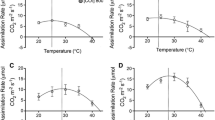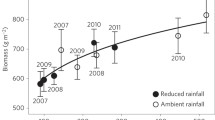Abstract
Under benign environmental conditions, plant growth is generally stimulated by elevated atmospheric CO2 concentrations. When environmental conditions become sub- or supra-optimal for growth, changes in the biomass enhancement ratio (BER; total plant biomass at elevated CO2 divided by plant biomass at the current CO2 level) may occur. We analysed literature sources that studied CO2×environment interactions on the growth of herbaceous species and tree seedlings during the vegetative phase. For each experiment we calculated the difference in BER for plants that were grown under 'optimal' and 'non-optimal' conditions. Assuming that interactions would be most apparent if the environmental stress strongly diminished growth, we scaled the difference in the BER values by the growth reduction due to the stress factor. In our compilation we found a large variability in CO2×environment interactions between experiments. To test the impact of experimental design, we simulated a range of analyses with a plant-to-plant variation in size common in experimental plant populations, in combination with a number of replicates generally used in CO2×environment studies. A similar variation in results was found as in the compilation of real experiments, showing the strong impact of stochasticity. We therefore caution against strong inferences derived from single experiments and suggest rather a reliance on average interactions across a range of experiments. Averaged over the literature data available, low soil nutrient supply or sub-optimal temperatures were found to reduce the proportional growth stimulation of elevated CO2. In contrast, BER increased when plants were grown at low water supply, albeit relatively modestly. Reduced irradiance or high salinity caused BER to increase in some cases and decrease in others, resulting in an average interaction with elevated CO2 that was not significant. Under high ozone concentrations, the relative growth enhancement by elevated CO2 was strongly increased, to the extent that high CO2 even compensated in an absolute way for the harmful effect of ozone on growth. No systematic difference in response was found between herbaceous and woody species for any of the environmental variables considered.
Similar content being viewed by others
Author information
Authors and Affiliations
Additional information
Electronic Publication
Rights and permissions
About this article
Cite this article
Poorter, H., Pérez-Soba, M. The growth response of plants to elevated CO2 under non-optimal environmental conditions. Oecologia 129, 1–20 (2001). https://doi.org/10.1007/s004420100736
Received:
Accepted:
Published:
Issue Date:
DOI: https://doi.org/10.1007/s004420100736




